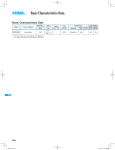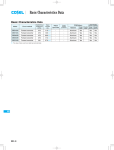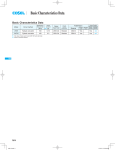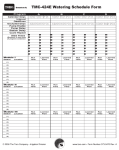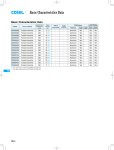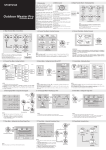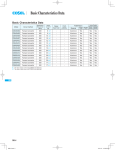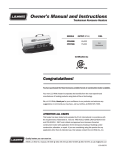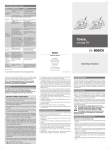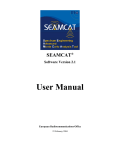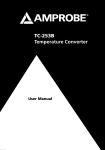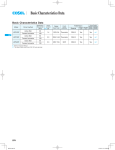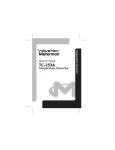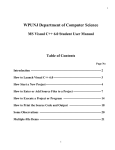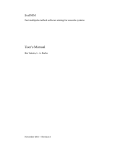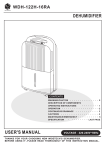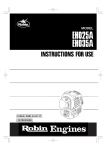Download Basic Characteristics Data
Transcript
Basic Characteristics Data Basic Characteristics Data Model Circuit method Switching frequency [kHz] DPF1000 Active filter 130 *1 The value of input current is at ACIN 100V and 1000W load. *2 The value of input current is at ACIN 200V and 1500W load. DPF DPF-4 Input current [A] 11.5 *1 8.5 *2 Rated input fuse Inrush current protection - SCR Material Single sided Series/Parallel operation availability Double Series Parallel sided operation operation Aluminum Yes No PCB/Pattern Yes AC-DC Power Supplies Power Module type Instruction Manual 1 Pin Connection DPF-6 2 Input Voltage Derating DPF-6 3 Standard Connection Method DPF-6 4 5 6 3.1 Standard connection method DPF-6 3.2 External components DPF-6 3.3 Wiring input pin DPF-7 3.4 Connection of loaded circuit DPF-7 3.5 Heatsink DPF-7 Function DPF-7 4.1 Overcurrent protection DPF-7 4.2 Overvoltage protection DPF-7 4.3 Thermal protection DPF-7 4.4 Auxiliary power supply circuit for external signal(AUX) DPF-7 4.5 Inverter operation monitor(IOG) DPF-8 4.6 Enable signal(ENA) DPF-8 4.7 Isolation DPF-8 Series and Parallel Operation DPF-8 5.1 Series operation DPF-8 5.2 Parallel operation DPF-8 5.3 N+1 redundant operation DPF-9 Implementation Mounting Method DPF-9 6.1 Mounting method DPF-9 6.2 Stress onto the pins DPF-9 6.3 Cleaning DPF-9 6.4 Soldering DPF-9 6.5 Derating DPF-10 DPF-5 DPF AC-DC Power Supplies Power Module type 3 Standard Connection Method 1 Pin Connection AUX CB AC1 IOG ENA -VOUT AC2 +VOUT R Instruction Manual 3.1 Standard connection method nTo use DPF1000, connection shown in Fig.3.1 and outside attached components are required. Through this connection, DC output voltage can be obtained from AC input voltage. AC input voltage and DC output voltage are not insulated. Bottom View Table 1.1 Pin connection and function No. Pin connection Heatsink Function DPF series F1 AC1 Noise AC IN Filter AC Input AC2 R External resistor for inrush current protection +VOUT +DC Output -VOUT -DC Output AUX Auxiliary power supply for external signal IOG Inverter operation monitor CB Current balance ENA Enable signal No. FG R +VOUT AC1 C1 -VOUT AUX AC2 FG R1 TH1 F2 R2 DBS series LF1 C2 C3 C5 PC1 +VIN -VIN RC1 ENA C4 Fig.3.1 Standard connection method Table 3.1 External components Reference No. Symbol 3.3 ”Wiring input pin” F1 Input fuse 20A or less Slow-blow type F2 Output fuse 10A or less Normal-blow type C1 Input capacitor 2 F or more, Rated ripple current : 9A or more, Film capacitor, Safety approved type C2 Output capacitor 1 F or more, Rated ripple current : 8A or more, Film capacitor C3 Holdup capacitor 220 - 2200 F Aluminum electrolytic capacitor C4 Y-capacitor 2200pF Safety approved type R1 Inrush cuurent protection resistor 4.7 - 10 Wirewound Resistor with Thermal Cut-Offs 3.4 ”Connection of loaded circuit” 4.4 ”Auxiliary power supply for external signal” 4.5 ”Inverter operation monitor” 5.2 ”Parallel operation” 4.6 ”Enable signal” 2 Input Voltage Derating Required characteristics Component 3.2 ”External components” nFig.2.1 shows rated output for each input voltage section. Maximum output should be within this range. 3.2 External components F1 1500 Input fuse : 20A or less Fuse is not built-in at input side. In order to secure the safety, use the slow-blow type fuse F1 (20A or less). Output power [W] DPF F2 Since over current protection is not built-in, use the normalblow type fuse F2 (10A or less) at output side to secure the 1000 950 safety. 850 C1 85 90 95 170 Input voltage [AC V] DPF-6 Output fuse : 10A or less Fig.2.1 Input voltage derating curve Input capacitor : 2 F or more Install an external capacitor C1 (2 F or more) to keep stable operation and to avoid failure. Use AC250V rated voltage with safety approved and over 9A rated ripple current. AC-DC Power Supplies Power Module type C2 Output capacitor : 1 F or more Install an external capacitor C2 (1 F or more) as close as pos- Instruction Manual 4 Function sible to the output pins to keep stable operation and to avoid failure. Use DC400V or higher rated voltage and over 8A rated ripple current capacitor. C3 4.1 Overcurrent protection nThe overcurrent protection circuit is not built-in. Holdup capacitor : 220-2200 F Since holdup capacitor is not built-in, install electrolytic ca- 4.2 Overvoltage protection pacitor C3 (220 - 2200 F) close to the ouput pins. The rated nThe overvoltage protection circuit is built-in. The AC input should ripple current of C3 and the holdup time for module should be be shut down if overvoltage protection is in operation. The mini- considered. The capacitor value should be within 220 to mum interval of AC recycling for recovery is a few minutes which 2200 F to avoid failure. output voltage drops below 20V. When this function operates, the power factor corrector function C4 Y-capacitor : 2200pF does not operate, and output voltage becomes the full-wave recti- Install an external capacitor C4 (2200pF) to keep stable oper- fied AC input voltage. ation. Use AC250V rated voltage with safety approved capacitor. Remarks: Please note that the unit's internal components may be damaged R1 Inrush current protection resistor : 4.7 - 10 if excessive voltage(over rated voltage) is applied to output termi- Connect a resistor between R pin and +Vout pin for inrush nal of power supply. This could happen when the customer tests current protection. The surge capacity is required for R1, the overvoltage performance of the unit. please contact component mfg. Wirewound resistor with thermal cut-offs type is required. 3.3 Wiring input pin 4.3 Thermal protection nThermal protection circuit is built-in and it operates at 100 15 . If this function comes into effect, shut down the output, eliminate all nA noise filter is not built in this power supply. Connect an external possible causes of overheating, and drop the temperature to nor- noise filter to reduce the conducted noise to the power supply line. mal level. To prevent the unit from overheating, avoid using the nA fuse to protect input is not built in. To assure safety, install a slow-blow fuse of 20A maximum to the input circuit F1. unit in a dusty, poorly ventilated environment. When this function operates, the power factor corrector function does not operate, and output voltage becomes the full-wave recti- 3.4 Connection of loaded circuit fied AC input voltage. nFor connecting the DBS/DAS series, see Fig.3.1. For details of F2, LF1 and C5, refer to the instruction manual for the DBS/DAS series. LF1 may not be required, depending on the noise standard or the design of the printed circuit board. In this case, ENA and RC1can be directly connected, without having PC1. nControl load current so that it may flow only when the terminal ENA is at ”L”. At ”H” when inrush current protection circuit is not released, excessive current may be applied to the circuit. nFor connection of loads except the series DBS/DAS, please contact Cosel development department. 4.4 Auxiliary power supply circuit for external signal(AUX) nThe AUX pin can be used as the power source with the open collector output(output voltage DC 6.5 - 8.5V, maximum output current 10mA) for lOG and ENA. nWhen used with AUX pin of additional units of this model for parallel connection, make sure to install a diode and that the maximum output current must be below 10mA. nNever let a short circuit occur between the AUX pin and other pins. It may damage the unit. 3.5 Heatsink nThe power supply adopts the conduction cooling system. Attach a heatsink to the aluminum base plate to cool the power supply for use. Refer to 6.5 Derating. DPF-7 DPF AC-DC Power Supplies Power Module type Instruction Manual 4.5 Inverter operation monitor(IOG) 5.2 Parallel operation nUse IOG to monitor operation of the inverter. nParallel operation is available by connecting the units as shown in When unit operation stopped due to overvoltage protection, ther- Fig.5.1. mal protection or the event of a failure in the power supply, IOG nAs variance of output current drew from each power supply is signal state changes to ”H” from ”L” within 1 second. And output maximum 10%, the total output current must not exceed the voltage becomes an equal value to the full-wave rectified AC in- value determined by the following equation. put voltage. If IOG signal status keeps ”H”, there is a possibility that unit (Output current in parallel operation) = (the rated current per unit) and/or external circuit is damaged. In case like this, please check (number of unit) 0.9 the unit and/or external circuit conditions in your system. nIOG can be used for monitoring failures such as redundant opera- DPF In parallel operation, the maximum operative number of units is 5. tion. nIOG may become unstable in case of start-up or sudden change of load current. Set the timer with delay of more than 5 seconds. nDuring parallel operation, unstable condition may occur when nWhen the output-line impedance is high, the power supply is become unstable. Use same length and thickness(width) wire(pattern) for the current balance improvement. nConnect each input pin for the lowest possible impedance. load current becomes lower than 10% of rated value. When the number of the units in parallel operation increases, input current increases. Adequate wiring design for input circuitry 4.6 Enable signal (ENA) nUse ENA to control starting of the loaded power supply. nWhen inrush current protection circuit is released, ENA outputs ”LOW”. nIf load current flows without releasing of the circuit, the resistor may be burnt. quired. nIf temperatures of aluminum base plates are different in the power supply for parallel operation, values of output current will change greatly Design radiation to equalize plate temperatures by attaching the same heatsinks. Table 4.1 Specification of TMP, IOG No. such as circuit pattern, wiring and current for equipment is re- IOG Item 1 Function ENA Normal operation ”L” Output possible ”L” Malfunction of inverter ”H” 2 Base pin nOutput diode Di is not required if capacity of output smoothing capacitor for parallel connection is below 2,500 F. Output prohibited ”H” F2 -VOUT 3 Level voltage ”L” 0.6V max at 10mA 4 Level voltage ”H” Open collector 5 Maximum sink current 10mA max 6 Maximum applied voltage 35V max F1 AC IN Noise Filter FG R DPF +VOUT AC1 -VOUT AUX AC2 ENA FG CB F3 Di R DPF +VOUT AC1 -VOUT AUX AC2 ENA FG CB F3 Di R DPF +VOUT F3 Di +VIN -VIN F2 4.7 Isolation nFor a receiving inspection, such as Hi-Pot test, gradually increase (decrease) the voltage for a start(shut down). Avoid using Hi-Pot tester with the timer because it may generate voltage a few times higher than the applied voltage, at ON/OFF of a timer. F2 5 Series and Parallel Operation AC1 AC2 -VOUT AUX ENA FG CB 5.1 Series operation nAs input and output are not insulated, series operation is impossible. Fig.5.1 Parallel operation DPF-8 RC1 AC-DC Power Supplies Power Module type F2 F1 ~ + AC IN Noise Bridge Filter Diode FG ~ R DPF +VOUT AC1 -VOUT AUX AC2 ENA FG CB F3 Di R DPF +VOUT AC1 -VOUT AUX AC2 ENA FG CB F3 Di Instruction Manual nHigh-frequency noise radiates directly from the unit to the atmosphere. Therefore, design the shield pattern on the printed circuit +VIN board and connect its one to FG. The shield pattern prevents noise radiation. -VIN F2 RC1 6.2 Stress onto the pins nWhen too much stress is applied to the pins of the power supply, the internal connection may be weakened. As shown in Fig.6.1 avoid applying stress of more than 29.4N(3kgf) on the input pins/output pins(A part) and more than 9.8N(1kgf) to the signal F2 R DPF +VOUT AC1 -VOUT AUX AC2 ENA FG CB F3 Di pins(B part). nThe pins are soldered on PCB internally, therefore, do not pull or bend them with abnormal forces. nFix the unit on PCB(fixing fittings) to reduce the stress onto the pins. A B A B part A part Fig.5.2 N+1 redundant operation Less than 29.4N (3kgf) 5.3 N+1 redundant operation Less than 29.4N (3kgf) Less than 9.8N (1kgf) Less than 29.4N (3kgf) Less than 9.8N (1kgf) Less than 9.8N (1kgf) nlt is possible to set N+1 redundant operation for improving reliabilFig.6.1 Stress onto the pins ity of power supply system. Connect as shown in Fig.5.2. nPurpose of redundant operation is to ensure stable operation in the event of single power supply failure. Since extra power supply is reserved for the failure condition, so total power of redundant operation is equal to N. 6.3 Cleaning nClean the product with a brush. Prevent liquid from getting into the product. Do not soak the product into liquid. nDo not stick solvent to a name plate or a resin case. (If solvent sticks to a name plate or a resin case, it will cause to 6 Implementation Mounting Method 6.1 Mounting method nThe unit can be mounted in any direction. When two or more power supplies are used side by side, position them with proper intervals to allow enough air ventilation. Aluminum base plate temperature around each power supply should not exceed the tem- change the color of the case or to fade letters on name plate away.) nAfter cleaning, dry them enough. 6.4 Soldering nFlow soldering : 260 Iess than 15 seconds. nSoldering iron AC IN/DC OUT/R pins : 450 Iess than 5 seconds. Signal pins Iess than 3 seconds(less than 20W). : 350 perature range shown in derating curve. nAvoid placing the AC input line pattern lay out underneath the unit, it will increase the line conducted noise. Make sure to leave an ample distance between the line pattern lay out and the unit. Also avoid placing the DC output line pattern of DC-DC converter underneath the unit because it may increase the output noise. Lay out the pattern away from the unit. DPF-9 DPF AC-DC Power Supplies Power Module type 6.5 Derating nUse with the conduction cooling(e.g. heat radiation by conduction from the aluminum base plate to the attached heat sink). Fig.6.2 shows the derating curve based on the aluminum base plate temperature. In the hatched area, the specification of Ripple and Ripple Noise is different from other areas. DPF Load factor [%] 100 80 60 40 20 0 -20 -10 0 10 20 30 40 50 60 70 Aluminum base plate temperature Tc [ ] Tc Measuring point Fig.6.2 Derating curve DPF-10 80 85 90 Instruction Manual







